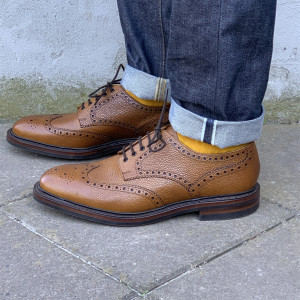Step 1
The first step in Goodyear welting is to prepare the insole for stitching. This is done by creating a rib perpendicular to the face of the insole through which shoemaker’s twine can be stitched. There are three major methods for doing this. First, the rib can be carved out by hand from the face of the insole using specialized shoemaker’s cutting tools. To the best of my knowledge, only makers who welt their shoes by hand use this method anymore, and I’m not even sure if it’s possible to machine-welt a shoe with a carved insole. Second, a cut can be made into the edge of the insole and the rib turned back and stabilized with linen tape or other mechanisms. I believe that this was the original method for rib creation used in machine-welted shoes; but today, the only manufacturer that I know of that still uses it is JM Weston. Third, a rib made of stiffened linen tape can be glued (gemmed) onto the insole. This sounds like a shoddy procedure unlikely to produce a quality shoe, but this is not the case. When done properly, the gemming is extremely secure and long-lived, and the linen rib can take as many reweltings as a cut-and-turned rib.
Step 2
The second step is in lasting the shoe. This means that the upper (with its lining) is pulled tightly over the last and secured to it, along with the insole. Lasting can either be done by hand using shoemaker’s pliers and elbow grease, or it can be done by a machine. Most ready-made welted shoes use the machine.
Step 3
The third step is the actual welting. Here, shoemaker’s twine is sewn through the welt strip, the upper, and the rib of the insole. This is done with a lockstitch, which means that all of the stitching won’t unravel if one stitch becomes abraded or comes undone. Finally, another row of lockstitching connects the other side of the welt to the outsole. Both rows of lockstitching can be either done by hand or by machine. The machine is called a Goodyear welting machine and was invented by Charles Goodyear, son of the man who invented the process for vulcanizing rubber, in the 19th Century. His invention revolutionized shoe construction because it made mass manufacturing of shoes possible. Hand welting shoes is time-consuming, back-breaking process that can take more than 20 hours per pair of shoes. Operating a Goodyear welting machine takes skill, but a pair of shoes can be welted in minutes.


